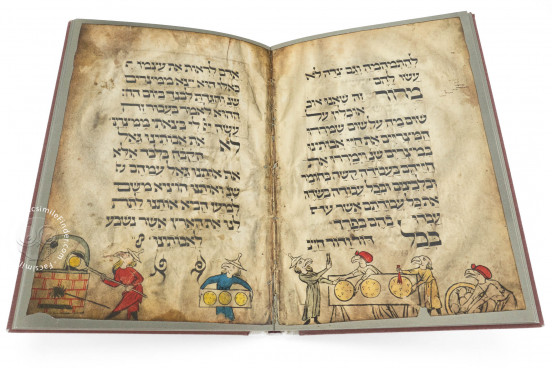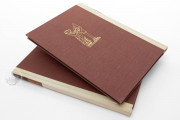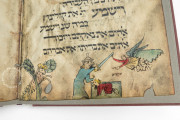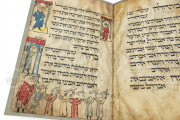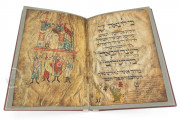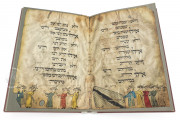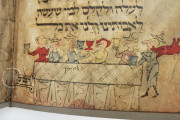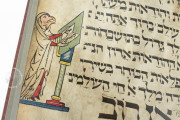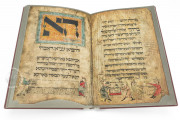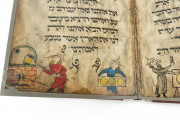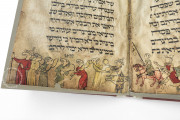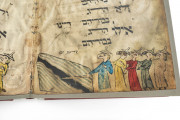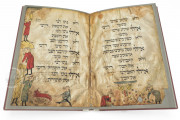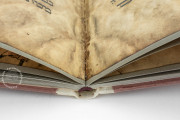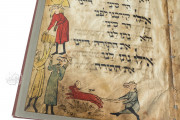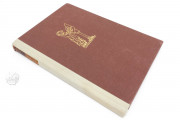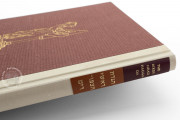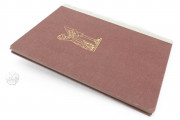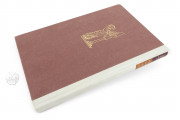The Birds' Head Haggadah is so named for its figural illustrations in which people are depicted with large bird-like heads, often with pointed ears—perhaps meant to be the heads of griffins—rather than with human features. Also known as the Marum Haggadah for its previous owner, it was created in the Upper Rhine region of southern Germany around 1300. Its thirty-five paintings take the form of two full-page miniatures and thirty-three marginal vignettes.
The Bird's Head Haggadah is the earliest surviving illustrated German Haggadah manuscript, a compendium of blessings, biblical passages, commentaries, psalms, and instructions for conducting the seder, the ceremonial meal of the first evening or first and second evenings of the Jewish feast of Passover.
Images of Biblical History and Contemporary Life
The manuscript's illumination includes historical scenes from the book of Exodus of Hebrew scripture and contemporary scenes of the preparations for the seder. The first and the last images are full-page miniatures, the first (damaged) picturing a couple at the seder table (fol. 1v) and the last showing the Heavenly Jerusalem (fol. 47r) in response to the text's concluding words: "Next year in Jerusalem!"
The manuscript offers a glimpse into the cultural practices of Jewish people in southern Germany at the turn of the fourteenth century. Many of the vignettes depict activities associated with the celebration of the feast of Passover and its seder meal, revealing aspects of contemporary dress and ritual practices.
One opening (fols. 22v-23r) features an illustration of the Dayenu, a much-beloved song of thanksgiving for the Lord's gifts to the Jewish people. In the bas-de-page of the verso, manna and quails falling from heaven are gathered by the Israelites, and, on the facing page, Moses receives two tablets and delivers five tablets (representing the five books of the Torah) to the people.
Birds' Heads and Blank Faces
The illustrations of the Haggadah are populated by humans of two types. Contemporary Jews and the biblical Israelites are represented with birds' or griffins' heads, while other faces—those of the sun, the moon, angels, and non-Jews—are, or originally were, blank. The reasons for this are not fully understood. Some of the originally blank faces were later supplied with features, some of which were subsequently effaced.
Most of the contemporary male Jews and biblical Israelites are depicted wearing the cone-shaped hat that was mandated for Jews in parts of Europe at the time the manuscript was made.
A Named Scribe
The manuscript's main text is written in Hebrew Square Script by a single scribe whose name, Menahem, is embedded in the text. Additional texts, including instructions for conducting the seder and captions for the illustrations, have been added in the margins over the centuries. Some of these additions were made within a generation of the book's creation while others were made considerably later.
A Wedding Present
It is reported that Samson Bibatz bought the manuscript in 1864 from a Herr Meier. The manuscript's last private owner, Ludwig Marum, received the book as a wedding gift from his wife's family, the Benedikts. The manuscript was acquired by the Bezalel National Museum in 1946. It became part of the collection of the Israel Museum upon its establishment in 1965.
We have 1 facsimile edition of the manuscript "Birds' Head Haggadah": Birds' Head Haggadah facsimile edition, published by Tarshish Books, 1965
Request Info / Price
